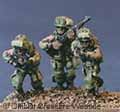 |










|
 |
 |
 |
 |
 |
 |
In the centre
of the board is a village. A road leads from one corner to the centre
of the village. Either side of the road, at the table edge, is some
good cover. As always, thereís lots of terrain/cover all around. The
attackerís objective is towards the edge of the village, thus
reasonably near the centre of the board, but on the far side of the
village from the road. For me, the objective was a V2 rocket on its
launch pad. I also had a couple of large ponds, which were impassable
areas which didnít block line of sight, forcing troops and vehicles to
circle around them, which worked quite well.
The defender has one company of green troops, which he may place on
the board anywhere he likes. There is an on-table mortar or two, and
machine-gun positions. The attacker has two companies of veterans
(perhaps paras), with off-table mortar support, and some infantry
anti-tank weapons.
He must get on the table and get some specialist troops next to the
objective and leave them there for five of his phasing initiatives. He
may come on the board from one or two positions of his choice (aerial
photography has pin-pointed the position of the objective).
After an agreed number of initiatives, reinforcements arrive for the
defender, coming along the road (vehicles) and alongside the road
(infantry), having received an urgent request from the defenders. Die
rolls should be involved for this, and the reinforcements should not
all arrive at once. For instance, one might count a vehicle as one
point and a platoon as one point. After, say, eight defenderís
initiatives, a die can be rolled, to see if any reinforcements arrive
next initiative, with a five or six indicating a yes. Every defenderís
initiative thereafter, a die roll determines how many points arrive. I
would suggest something like (1d6+1)-1d6, so a third of the time, no
reinforcements show up, and possibly a lot show up. We diced randomly
for what kind of reinforcement turned up: infantry or vehicles, or
infantry in vehicles. You may allow the defender to choose. You may
set a limit on the number of reinforcements, but we found this to be
unnecessary. Reinforcements may be regular, but not veteran.
In the five initiatives that the attacker spends next to the
objective, his specialist troops may photograph the technological
marvel, or find the blueprints in the office, or find all the bits to
the enigma machine, or destroy the mechanism which works the cable
car, or plant the dead body with the fake plans on it, or set the
charges on the pipeline junction, or break open the safe with the
prototype device in it, or brief the double agent, or bury the homing
beacon, or paint "Hitler has only got one ball" all over the staff HQ
or do whatever it was which they had come to do. Once done, they get a
major victory if they can get off table with most of their force.
Other things to spice up this scenario are: all units next to the
objective are killed after a certain time (the charges go off, the
rocket launches); (some of) the specialist unit(s) must get away after
spending five initiatives next to the objective. I played the scenario
with several units having been trained to do the main task. If only
one squad could carry out the objective, this would make the scenario
very brittle for the attacking player.
Perhaps the main choice for the attacker is whether to come on near
the road or not. In the play test, attackers who came on the far side
from the road, to concentrate on getting to the objective quickly with
as many troops as possible, then found that they had no way of
stopping the reinforcements from getting on the table, whereas the
advantages of defence (not having to move, incurring reactive fire;
protected machine guns) were such that it could take even veterans a
lot of time time to get on to the table and to the objective, if not
substantially out-numbering the defenders.
Lloyd Nikolas |
 |



|
 |
 |
|

[ Home ] [ Up ] [ Crossfire Review ] [ Crossfire Tactics ] [ Unit Identification ] [ Tips for the Novice ] [ Gebirgsjager 1943 ] [ Luftwaffe Regt ] [ River Crossing ] [ The Raid! ]
The CROSSFIRE Website is edited and maintained
by John Moher. Additional contributions were made by John Kovalic, Luca Fazio,
and William Scarvie III. CROSSFIRE is © 1996 Arty Conliffe. The contents of
these pages are © 1996-2009 John Moher, Arty Conliffe, Rob Wolsky, Bill
Rutherford, and/or the appropriate Authors and Contributors.
|
|
 |



